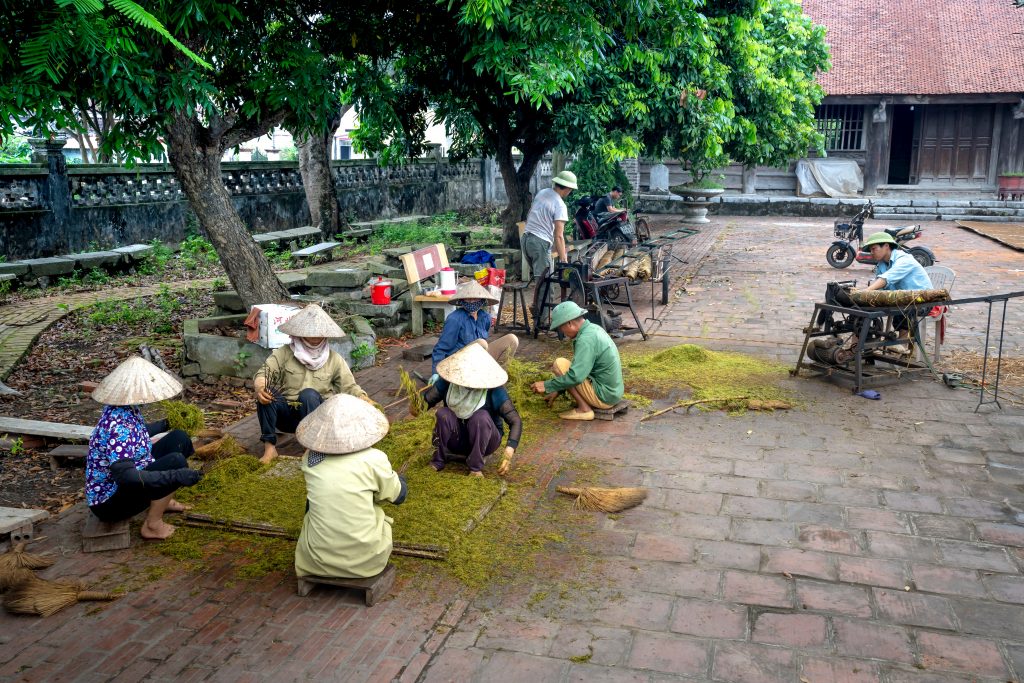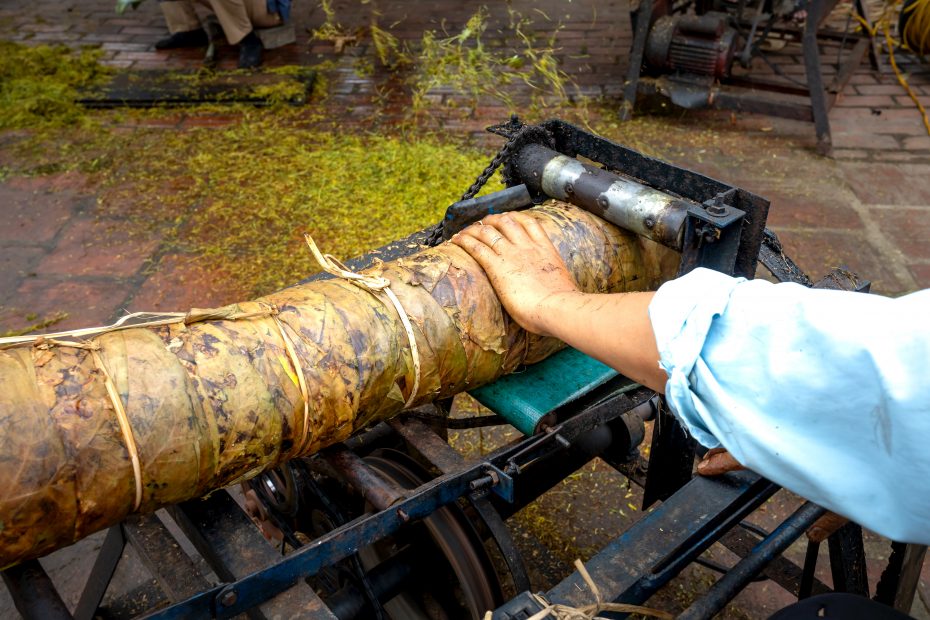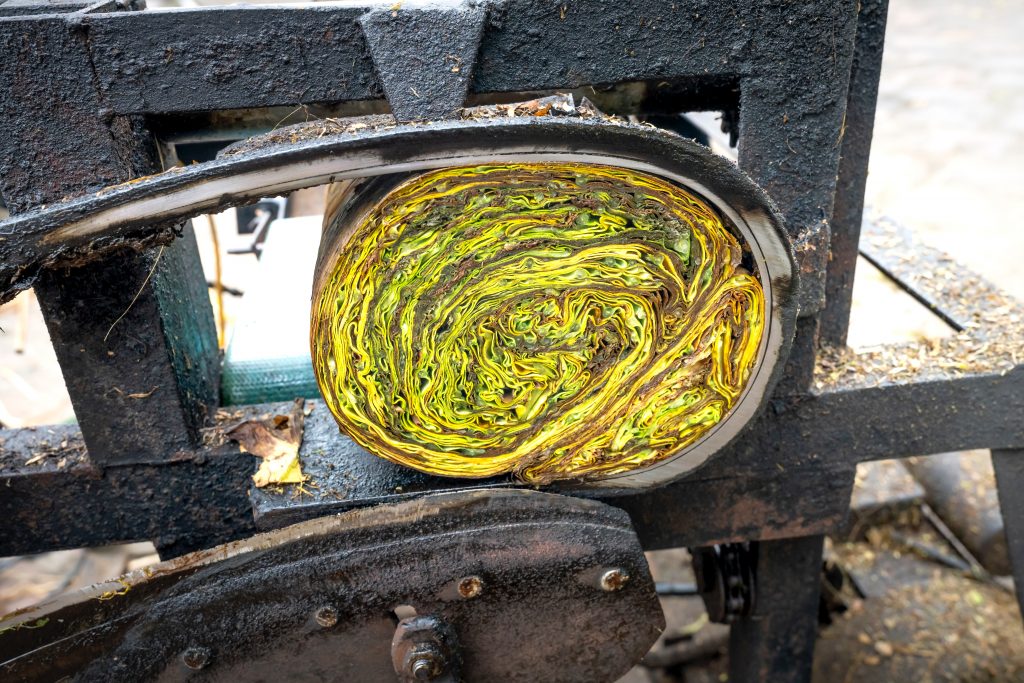How Tea Is Processed
White Tea
White tea is the most natural and simple tea of all. The leaflets rich in white down (which gives the tea its name white tea) are harvested, spread out to dry in a very short time to prevent any oxidation process.
Production steps
- Hand harvesting of fresh leaves
- Cooling/ventilation of leaves for about 2-3 hours.
- Drying of leaves on bamboo mats or in baskets for about 10-14 hours with 60% air humidity and an ambient temperature of 25-26°C.
- First drying cycle, duration of about 10-15 min at a temperature of 100°C-130°C.
- Sorting/grading by hand
- Second drying cycle, duration of about 12 min at a temperature of 130 ° C
- Mixing and packaging
Scented Tea
As early as the Ming Dynasty, the fresh petals of certain flowers were used in addition to tea to create new flavors and fragrances.
With their pleasant and delicate fragrance, the flowers (e.g., jasmine, or magnolia, or osmanthus) are picked from the plant at the height of flowering and are added to the finished tea. After that, the result combination is heated. To get the ideal ratio of ingredients, one must be extremely skilled and experienced in this very delicate process. The tea receives the full aroma of the heated blossoms. The more frequently this process is repeated, the higher the tea’s quality. This flavoring procedure is repeated up to eight times in the best scented jasmine teas.
Yellow Tea
Yellow tea although little known, has a long tradition as oolong tea. Its place is between green tea and oolong tea. Because of its revitalizing effect and many beneficial properties, yellow tea has long remained a privilege of Buddhist monks. There are extremely few types available, and there aren’t many of them too. It is famous for its aroma with hints of chestnut and hazelnut.
Production steps
- Harvesting of fresh leaves mainly from the wild growth of tea bushes
- Drying of the leaves in the open air for about 2 hours
- Dry heat for approximately 6-7 minutes at 180–200 °C to remove enzymes. this process is carried out by hand.
- Cooling of the leaves on bamboo mats for about 30 minutes.
- Now the leaves are rolled for about 30-45 minutes, and depending on the quality of the tea this process is done either mechanically or by hand.
- The tea is produced in little amounts and kept for two to ten hours in a space with constant humidity and a temperature of around 26 °C. This process called killing the green gives the tea leaves their yellowish color.
- The leaves are then dried over a charcoal fire at a temperature of about 150-160°C.
- A subsequent cooking cycle follows at a temperature of 200°C.
- The finished tea is set to cool and then packaged.
Oolong Tea
Semi-oxidized teas include oolong tea. The oxidation process gives it its distinctiveness. The central part of the leaf remains unoxidized while the edge or outer part is completely oxidized. The time for the oxidation process to stop depends on what kind of oolong is desired, and tea masters are very careful and extremely knowledgeable. Due to the various oxidation rates, some oolong teas have reddish brown leaves, while others have leaves that appear to be green.
Production steps
- Harvesting of fresh leaves
- Withering
- Cooling of the leaves for about 30 minutes
- Starting the oxidation process by rolling the edges of the leaves while simultaneously supplying them with hot or cold air, depending on the temperature outside.
- Dry heat oxidation for 3-5 minutes at a temperature above 250°C.
- First drying cycle, duration of about 17 minutes at temperature of 150°C-160°C
- Modeling
- A second drying cycle at 130°C to 140°C for around 30 minutes
- Selection into different qualities of leaves
- Removal of stems by hand
- If necessary, another heating cycle with dry heat.
- Packaging

Pu-Erh Tea
Pu Erh tea differs from familiar orthodox teas because of its special fermentation process, which unlike black or oolong teas (which are oxidized by air) is fermented with a chemical agent. The result is a very special tea, rich in health benefits, with a strong undergrowth flavor. Pu Erh tea is originally and traditionally produced in Yunnan province, in the Xishuangbanna district. There are numerous ethnic groups that live in this area, and each of them has a unique method for making and consuming Pu Erh tea.
Production steps
- Harvesting of fresh leaves
- Fresh leaves are kneaded and turned
- Withering for about 5 hours
- Lightly heated for 20–40 seconds using dry heat at a temperature of 80–100°C
- Rolling for 30-50 minutes
- Molding
- Drying in the open air
- Re-rolling
- Re-shaping
- Open-air drying
The primary material is this simple tea, often known as Qing Mao tea. The following is how the production process continues:
- Fermentation for 40 to 50 days in a moist atmosphere. Throughout this time, the tea is frequently turned. The balance of oxygenation, humidity, and room temperature must be carefully considered. Bacteria are occasionally intentionally injected during this postfermentation process, depending on the quality of the water.
- Sorting and mixing
- Killing bacteria through dry heat at temperatures above 150°C.
The longer the tea is aged after this process, the higher its quality will be.
Next, Pu-Erh can be pressed into different nest or brick or cake shapes, thus these further types are distinguished: Pu Erh Tuo Cha, Pu Erh Square Tea, Pu Erh Beeng Cha
Green Tea
Green Tea – Chinese Style
Machine production: Flaking machines are used to produce the highest possible yield with very little labor. The upper 2-4 leaves and leaf bud are pinched off, along with the plant stems.
Production stages:
- Harvesting of fresh leaves.
- Withering, as needed
- Heating for c. 30 seconds at a temperature of about 150°C
- Rolling, c. 45 min
- Forming, as required
- First drying cycle, duration c. 30 min at a temperature of 110°C-130°C
- Short cooling phase.
- A second drying cycle between 90°C and 110°C lasting around 30 minutes.
- Removal of stems
- Blending and packing
Manual production: Comparatively high-quality teas, available only in limited quantities, are produced by hand from the harvest, which is done by hand. In some cases, they are even produced only to order
Production stages:
- Harvesting of fresh leaves
- Cooling/ventilation of the leaves for about 1 hour
- Drying for 5-10 minutes at a temperature of about 180°C and dry heat
- First rolling cycle, lasting about 10 min
- First drying cycle, lasted about 8-10 min at a temperature of 110°C-130°C
- Second rolling cycle, also lasted about 10 min
- Second drying cycle, also lasted about 8-10 min at a temperature of 90 ° C-110 ° C
(h) Shaping
- Blending and packaging
Green Tea – Japanese Style
Japan produces only and exclusively Green Tea, so the teas produced in this country are highly prized and appreciated all over the world. Special machines are required in its production. Most tea leaves are broken, while high quality teas are traditionally made by hand. Japanese teas have a low amount of sturdy leaves, so they have sweeter flavor.
Production steps in mechanical production:
- Harvesting of fresh leaves
- Cooling/ventilation of leaves for about 1 hour, ideally in a cooling tunnel
- Withering with steam for about 45 sec at a temperature of about 100°C
- First step of removing stems and stems by hand
- Various rolling processes for a total period of about 90 min in one processing step.
- Shaping
- Drying for c. 15 min at a temperature of c. 70°C-80°C.
- Removal of stems
- First selection/grading into the various sizes of leaves
- Separation of the various leaf sizes by air blowing
- Mixing and packing
Black Tea
Black tea – orthodox production
Orthodox tea production provides any desired grade of leaves. Depending on the required tea grade and geographical conditions, leaves are harvested either manually or by machine.
Production stages
- Harvesting of fresh leaves and grading of leaves into various grades
- Blowing hot or cold air for 14 to 18 hours while drying in ventilated rooms with fans, depending on the weather. During this time, the leaves lose between 30 and 50 percent of their moisture content and become softer for the following process.
- Rolling: the walls and furrows of the leaves are broken; The released cell furrow binds with oxygen, thus creating the prerequisites for the oxidation process that follows. Two rolling processes of 40-50 minutes each are performed;
- Leaves are placed on shelves or on the floor of special oxidation rooms, with a thickness of about 10 cm for 2-3 hours exposed to their natural oxidation at a temperature of 27°C-33°C and a relative humidity of 80-90%.
- Drying: The tea comes to dry for about 24 minutes at a temperature of 116°C. The residual moisture in the leaf is about 6%.
- Cooling of the leaves
- Removal of stems by both hand and machine
- Sorting into various grades by sieving
- Packaging
Black tea – CTC production
With this shorter production method, leaf processing is done in a single process. The leaves are rolled, broken and crushed in one step. No leaves that can be graded are obtained, only Broken Pekoe, Pekoe Fannings y Pekoe Dust. Again, harvesting is done by hand or machine as needed.
Black tea – LTP production
The majority of tea bags are made using this technique.
No grade is recognized to the dried leaves, barely Broken, but mainly it is Fanning or Dust. The process is called LPT after the name of its inventor (Lawrie Tea Processor).
Similar to CTC production, freshly harvested leaves are fed into a rotary machine. The machine consists of rapidly rotating blades that cut the leaves quickly until Fanning and Dust are formed.
Tea Blends – Orthodox
Life stories contained in a cup of tea. Tea has influenced human life more than any other beverage, influencing caravans over deserts, choppy seas, and lovely sunset hours in colonies. So it is that even here in Europe tea rituals have evolved around tea culture.
Whether the tea ceremony comfortably savored in the Frisian Islands, the refined afternoon tea of the English aristocracy, or tea served from shiny Russian Samovars, these traditions have something wonderfully nostalgic about them, evoking memories and keeping different peoples together.
Many of our blends follow the preferences of different cultures that have approached tea since time immemorial. Immerse yourself in the world of tea. Experience tea in all its diversity: from the simple to the refined, from the strongest to the sweetest. An endless choice to travel through time and space and reach places and moments of the past with your imagination.

